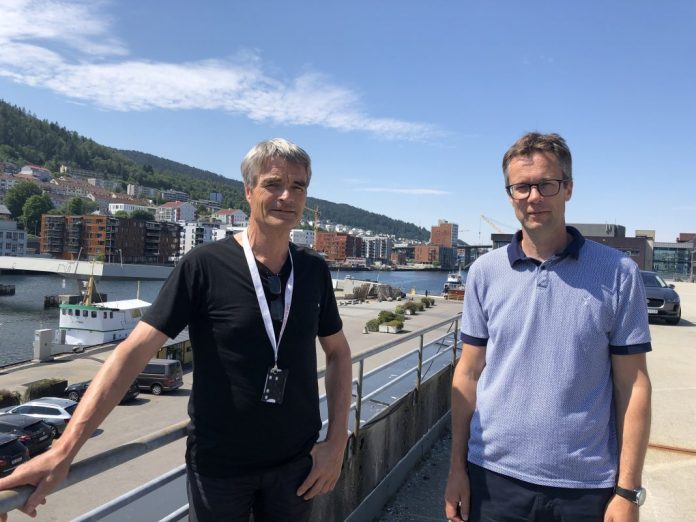“The advantage here is, as we see it, that one can deliver an RAS plant, fully certified from shipyards”. Brand new thinking in a fresh partnership.
They squint at the bright sun. It is hot on the roof terrace close to Lerøy’s headquarters in Bergen, Norway. Arne Ottesen and Eldar Lien, from Leirvik and SeaRAS respectively, have found the tone. Both will cooperate in innovative, pioneering work in new sectors.
The start-up company SeaRAS has its offices, has been going for three years and has five employees. They’re all engineers from the oil industry.
“We started with an application for development licences in the sea,” Lien said. “We applied for 12 development licences and were rejected, which was not very strange. It was too new. We didn’t have enough proven technology. We hadn’t done detailed anchoring analyses, some things that they had a hang up on.”
Reactor
“It was a pity, but it led us to take that solution ashore. Because land-based RAS facilities are in fashion. So we have built a prototype lab out in Arna (in Bergen .ed) that we run and test. We have built the technology, developed solutions around the RAS reactor, and it was in that regard I was invited to a conference in Oslo to present this together with the big guys, Aker and all of these.
“And there I met Geir from Leirvik, who came over and talked a little during the break, who said that this will be a nice RAS solution. A compact solution where we have all the water treatment in the same unit, and that it will be suitable to prefabricat it in shipyards. Test it and get it ready, to put it on a barge and send to the customer. And that is the solution we will now go into the market with,” said Lien.
“We work based on that technology, and then we got into this and found that it was a nice match,” said Arne Ottesen, executive vice president for engineering and technology at Leirvik.
While SeaRAS is running with the technology, Leirvik can make it industrialized.
“We were two entrepreneurs, Morten Aga and me, who started it and worked out the technology. The main artery in that reactor is an aqueduct, i.e. a water transfer, which aerates for CO2 and skimmers in the same unit.
So you’ve entered into a strategic alliance?
“We have entered into a cooperation agreement to develop this. We aren’t committing more than working together to bring out a product and offer it,” said Ottesen.
Aqueduct
“You have the outer tub and the biofilter lying in a ring volume around the centre fish tank. And centre pillars that go up with four walkways and aqueduct,” Lien said enthusiastically. “We take water from the centre of the tank, re-enter these four units in and out of the biofilter. The water flows through the biofilter and into the fish tank. On the road here, we drive CO2 aeration and skimming and get to cover the processes in the RAS facility while transporting the water out to the biofilter.”
“Then we have a side current that also runs from the centre, from the bottom, to separate drum filters. So we have four independent water pipes with an aqueduct and a drum filter that can be run individually. We have good redundancy and operational security in the system. The tub is completely clean, there are no obstacles or anything that sticks down in the tub.
He explained that its easy to clean, has good hydraulics and little sedimentation. “That’s the main principle of the solution.”
“A unit of 30-34 meters weighs around 100 tonnes, so it is a small offshore module. It’s easy,” Ottesen said.
This provides a tank volume of 4-5.000 m3.

Tailored
“If the size of the tank is increased, you need to have greater capacity CO2 removal and particle removal,” said Lien.
The solution has three water changes per hour. And it can be tailored for the customer.
“The principal is a similar, but the dimension of the tanks can be depending on what one wants. We have now operated a tank that is 34 meters in diameter. The goal is to get a pilot customer now in the first round,” said Arne Ottesen.
“We have spoken to various salmon farming companies, one with us in workshops and given input. In recent weeks, we have begun to arrange meetings with others. It’s a sales process.”
“The advantage here is, as we see it, that one can deliver an RAS facility, fully certified from yards. The big dilemma for many salmon farmers is that they will build advanced facilities far from infrastructure. And then you’re going to have expensive engineers and plumbers and welders in and out. It is hugely costly and time consuming,” Lien pointed out.

Fully Norwegian
The new plant can be produced in full in Norway. The Leirvik Group has traditionally built living quarters for the oil industry, ever since 1974, when the first was delivered. It is a former family-owned business, now owned by Hitecvision, and part of the Moreld Group, where SalMar chairman Atle Eide is a partner.
“We are strongly encouraged to enter new markets. We have focused mainly on aquaculture and infrastructure. We have 250 employees, including 75 engineers, at Stord, delivering turnkey facilities. We want to industrialise this – so that not every facility has to be completely rebuilt,” Ottesen explained.
“We want to harness each other’s expertise,” he says, nodding to Lien. “We are used to building large sections and transporting it to the customer. For us, we think it’s a good match.”

